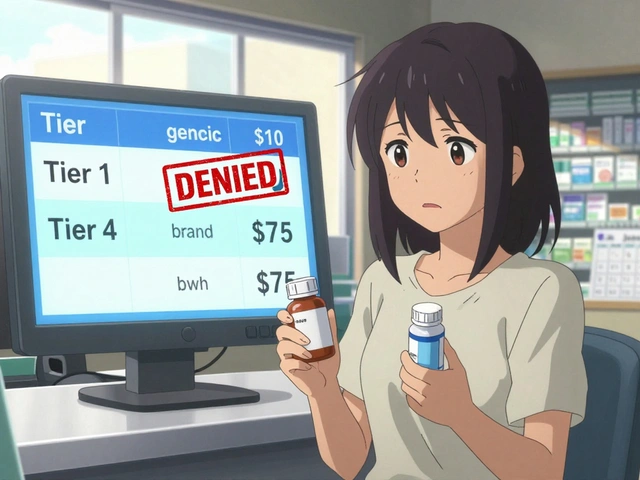Did you know that roughly one in three women over 50 will experience an osteoporotic fracture? It’s a mind-blowing stat and tells you just how crucial the debate between alendronate and denosumab has become. With more people living well into their 80s and 90s, the long game in osteoporosis management isn’t just about avoiding broken bones—it’s about picking a therapy that actually sticks the landing years down the road. If you’re on the fence or just want a straight answer about which treatment actually delivers on its promises, you’ve found the right place.
Bone Density Gains: Building More Than Just Hype
Let’s not sugarcoat it: when you’re trying to dodge hip or spine fractures, bone mineral density (BMD) matters. Alendronate, an oral bisphosphonate, has been around since the mid-90s. It’s the old-school heavy hitter slowly thickening up brittle bones by locking calcium in. The big picture? When taken properly (think: empty stomach, upright for 30 minutes), alendronate has proven to increase spine BMD by about 5–8% after three years of regular use. Not too shabby. The hip numbers echo these results, though usually lagging just behind the spine.
Denosumab, on the other hand, is an injectable treatment delivered once every six months. It came on the scene later but quickly picked up steam, especially for folks who struggle with pill routines or stomach issues. Multiple big-name studies, like the FREEDOM trial, have shown denosumab can boost lumbar spine BMD by 9–10% and hip BMD by around 6–7% after three years. What’s unique about denosumab, compared to alendronate, is the pattern of bone gain: improvements often continue as long as you keep up the injections, while alendronate’s gains tend to plateau after the first 3–4 years.
Why does this matter in real life? It means denosumab may offer more ongoing protection—if you plan to stick with it long term. That said, when you stop denosumab, bone loss can come back fast. Timing and follow-up really count. Alendronate, in contrast, leaves a “bone footprint”—its effects hang around for years even after you stop, which is handy if you ever need a medication break.
The table below breaks down some of the documented BMD changes from head-to-head trials and studies:
| Medication | Admin Route | Spine BMD Gain (3 Years) | Hip BMD Gain (3 Years) | Continued Long-Term Gain |
|---|---|---|---|---|
| Alendronate | Oral Weekly | 5–8% | 4–6% | Plateaus at 4 years |
| Denosumab | Injection (6 months) | 9–10% | 6–7% | Continues with ongoing use |
If you’re looking for a quick takeaway: denosumab generally wins in the “long-term BMD gain” department, provided you don’t miss a dose. Alendronate might be better for someone who wants steady improvement and a long half-life if stopping is ever required.
Practical Safety: What Real Users Experience
If only picking an osteoporosis med was as simple as reading the BMD numbers! Safety concerns tip the scales for many people—and here’s where it gets interesting. Alendronate’s got its quirks. The most talked-about one? Esophageal irritation or even ulcers, especially if you don’t follow those strict pill-taking rules. It can be harsh on the stomach, so if acid reflux or digestive issues already bug you, the risk goes up. Rarely, some people experience “atypical femur fractures” and jaw osteonecrosis after years of use, though these are far less common than the classic complaints.
Denosumab is often recommended when someone can’t tolerate bisphosphonates or just can’t swallow tablets comfortably. Since it’s a shot, your digestive tract gets a break. But it’s not free of drama: denosumab can cause low calcium (hypocalcemia), so your levels need checking, especially if you’ve got kidney issues. There’s also chatter about infections—mainly skin and urinary—but the bump in risk is pretty modest for most people. Ultra-rare side effects, like jaw problems or femur fractures, can crop up with both meds, although most data suggest such events cluster more around super long-term use.
If you’re nervous about what happens if you stop one of these drugs, there’s a twist. People coming off denosumab can see a rebound spike in bone turnover, which means an increased risk for fractures unless another med is started straight away. That’s not typically the case with alendronate, which is kind of the turtle of the osteoporosis med world—steady, slow, and persistent well after you quit.
Let’s toss in a few pro tips if safety is weighing on your mind:
- Can’t follow alendronate’s strict dosing? Denosumab might be your friend—just stay on schedule with injections.
- History of acid reflux? Alendronate’s probably not your best buddy.
- Already low on calcium or with kidney issues? Get labs checked before denosumab.
- Ever had dental surgery plans? Both drugs can make healing slower—flag it with your dentist first.
If you want a real-world safety snapshot, recent cohort studies (2023 and 2024) show major adverse events occur in less than 1 in 1,000 users per year on either medication. That’s reassuring, but the devil’s in the details: choosing between the two is really about the risks you personally face.

Cost Analysis: Counting the True Price of Stronger Bones
Let’s get candid—price matters, especially if the insurance copay or out-of-pocket bill looks like your rent. Alendronate is generic these days, so many pharmacies offer a month’s supply for less than the price of lunch. Some big box pharmacies keep it under $10 a month without insurance. If you qualify for coverage or pharmaceutical assistance, costs might be nearly zero.
Denosumab, sold as Prolia, comes with a quirker sticker. We’re talking $1,300 to $2,000 per injection (twice yearly) in the U.S. before insurance, though actual customer payments are often far less thanks to good drug plans or Medicare. Even so, denosumab almost always beats alendronate on the BMD numbers—but not the price. Coverage gaps are what trip people up; if you space out shots or lose insurance, bone strength can nosedive, and suddenly a cost-saving pause turns risky.
So, what actually influences what you’ll pay? Here are a few common variables:
- Insurance type (Medicare Part D often covers both, but copays can differ hugely)
- Pharmacy/clinic fees for injections for denosumab
- Patient assistance programs (check manufacturer sites for Prolia-specific aid)
- Need for extra calcium and vitamin D supplements (almost always needed on both)
There’s a strategy some folks use to blend effectiveness with affordability: start with denosumab for a few years, then switch to alendronate to “lock in” the gains while spending less. This “sequential therapy” is showing up in more long-term management plans and may be especially handy if you’re nearing a change in insurance or just don’t want to spend big forever.
Average yearly medication costs based on U.S. pharmacy data (2024):
| Medication | Estimated Yearly Out-of-Pocket Cost (No Insurance) |
|---|---|
| Alendronate (generic) | $120–$180 |
| Denosumab (Prolia) | $2,600–$4,000 |
The price tag comparison is straightforward: alendronate rules for affordability, but denosumab is the go-to if maximizing BMD is non-negotiable and you’ve got the coverage to back up the cost.
Long-Term Strategy: What the Latest Evidence Really Says
Okay, let’s pull apart what all of this means when you’re in it for the long haul. Clinical guidelines (as of mid-2025) don’t hand out a single “best” choice for everyone with osteoporosis. Instead, they favor customizing the game plan to fit who you are, your BMD results, your life, and your risk for trouble on either medication.
Alendronate is usually the “first stop” because it’s affordable, easy to access, and well-studied. If you’re a healthy adult with straightforward osteoporosis, you can reasonably expect a significant drop in hip and vertebral fracture risk for at least five years. Many doctors even recommend so-called “drug holidays” after that, using bone markers and new DEXA results to judge when (or if) you need to jump back in. Heads up: some bone gain hangs around, so you don’t lose protection overnight if you pause it.
Denosumab, meanwhile, shines brightest for people at high risk of fracture or those who’ve failed or can’t tolerate bisphosphonates. It keeps bones thickening year after year, provided you never miss a dose. But if you need to switch things up, you can’t just quit: you’ll need to slide over to an alternative to long-term alendronate or another bisphosphonate to stop rapid bone loss and minimize gaps in protection.
What’s the “win” for sticking to one over the other? If you’re stable, not at ultra-high fracture risk, want to keep costs chill, and are okay with pill routines, alendronate fits the bill. If you need the best BMD gains (and can handle the insurance rollercoaster), denosumab is tough to beat for extending bone health as long as you stay on it. There’s even fresh buzz around mixing strategies, like starting strong on denosumab and moving to alendronate once bone numbers peak—you sidestep long-term costs while keeping fracture protection tight.
So here’s the bottom line: both medications bring unmistakable strengths, with differences that matter more (or less) depending on your health, your risk tolerance, and your wallet. Ask your doctor point-blank where you fit in all this—because that’s where you’ll find the most reliable, lasting benefit.







Comments
siddharth singh
When evaluating alendronate versus denosumab for long‑term osteoporosis management, the clinician must first map the patient’s fracture risk profile onto the pharmacodynamic landscape of each agent.
Alendronate, a nitrogen‑containing bisphosphonate, exerts its anti‑resorptive effect by binding to hydroxyapatite surfaces and inhibiting farnesyl pyrophosphate synthase within osteoclasts, thereby reducing bone turnover in a dose‑dependent fashion.
This mechanism translates clinically into an initial rapid rise in bone mineral density that typically plateaus after three to four years of continuous therapy, as the bone remodeling space becomes saturated.
Denosumab, on the other hand, is a fully human monoclonal antibody that neutralises RANK‑L, the key ligand driving osteoclast differentiation, and its effect persists for the full six‑month dosing interval, allowing BMD gains to accrue steadily without the early plateau observed with bisphosphonates.
The longitudinal data from the FREEDOM extension study demonstrate that patients who remain on denosumab for up to ten years continue to accrue lumbar spine BMD improvements of roughly 1% per year, a pattern not seen with alendronate.
However, the pharmacokinetic half‑life of denosumab is essentially the dosing interval, meaning that any missed injection precipitates a rapid reversal of its anti‑resorptive shield, often manifested as a rebound increase in bone turnover markers and a transient spike in vertebral fracture incidence.
In contrast, alendronate’s skeletal binding affinity confers a “drug holiday” window; after cessation, residual drug remains embedded in bone matrix for months, providing a buffer against immediate bone loss.
Safety profiles further differentiate the agents: alendronate’s gastrointestinal irritability demands strict administration protocols-fasting, upright posture for a minimum of thirty minutes-to mitigate esophageal ulceration risk.
Denosumab bypasses the gastrointestinal tract entirely, but mandates vigilant calcium monitoring, as hypocalcaemia can develop, especially in patients with chronic kidney disease or concomitant vitamin D deficiency.
Economic considerations cannot be ignored; generic alendronate costs under $10 per month in most markets, whereas denosumab’s list price exceeds $1,500 per injection, imposing a substantial out‑of‑pocket burden absent robust insurance coverage.
From a health‑system perspective, cost‑effectiveness analyses consistently rank alendronate as the dominant first‑line option for average‑risk patients, while denosumab achieves incremental cost‑effectiveness ratios that become acceptable only in high‑risk cohorts or when oral adherence is demonstrably poor.
Moreover, emerging data suggest that sequential therapy-initiating denosumab to achieve rapid BMD gains and subsequently transitioning to alendronate to preserve those gains-may optimise both clinical outcomes and financial sustainability.
This strategy leverages denosumab’s superior early efficacy while capitalising on alendronate’s lingering skeletal reservoir, thereby mitigating the rebound fracture phenomenon associated with abrupt denosumab discontinuation.
Clinicians should therefore individualise treatment plans, weighing fracture risk, comorbid gastrointestinal disease, renal function, patient preference for oral versus injectable routes, and insurance landscape before committing to a lifelong regimen.
In practice, a shared‑decision model that presents these nuanced trade‑offs in plain language empowers patients to align therapy with their lifestyle, risk tolerance, and budgetary constraints.
Ultimately, the “best” drug is the one the patient can take consistently, safely, and affordably over the long horizon of osteoporosis management.
Angela Green
Just a quick note on the terminology used above – the generic name “alendronate” should be lowercase when not part of a brand name, and “Denosumab” stays capitalized as it’s a proper noun.
Also, remember that “bisphosphonate” is one word, not “bis‑phosphate”.
Grammar matters, especially in medical writing, because clarity saves lives!
April Malley
Wow, this breakdown is super helpful, and I love how it lays out the numbers side‑by‑side, because everyone needs a clear picture before making a decision, especially when costs are so wildly different, and the safety tips are a lifesaver, really, the table makes it easy to compare spine versus hip gains, and the bullet points on practical tips are gold, thanks for sharing!
scott bradshaw
Sure, because paying $2,000 for a shot is exactly what everyone loves.
Crystal Price
Honestly, picking a drug feels like choosing between a cheap, reliable bike and an expensive sports car – the bike (alendronate) might be slower but it won’t break your bank, whereas the sports car (denosumab) looks flashy but you might end up stranded without fuel.
The drama of a high‑priced injection can be overwhelming, especially when you hear about “rebound fractures” like a horror movie sequel.
At the end of the day, you have to ask yourself: do I want steady, affordable protection or a high‑risk, high‑reward gamble?
Either way, you deserve a treatment that doesn’t make your wallet scream.
Murhari Patil
Don’t be fooled – the pharma giants want you on denosumab because the profit margins are obscene, and they’ll hide the rebound fracture risk behind glossy marketing.
Every missed injection is a chance for them to push another expensive follow‑up, keeping you locked in the cycle.
Even the “sequential therapy” idea sounds like a way to keep you buying drugs forever.
Stay skeptical and demand transparent data, not just shiny price tags.
kevin joyce
From a mechanistic perspective, the ontological divergence between a small‑molecule bisphosphonate and a monoclonal antibody epitomises the shift from direct enzymatic inhibition to targeted ligand sequestration, thereby redefining the therapeutic axis of bone remodeling.
Alendronate’s affinity for hydroxyapatite mediates a pharmacokinetic reservoir effect, which underpins its drug‑holiday viability – a concept resonant with the principle of “biologic memory” within the skeletal compartment.
Conversely, denosumab’s reversible RANK‑L blockade furnishes a dynamic modulation of osteoclastogenesis, granting clinicians the ability to titrate anti‑resorptive intensity in a temporal fashion, albeit at the expense of reliance on strict adherence to the six‑month dosing cadence.
The cost–benefit calculus must therefore incorporate not only direct economic outlays but also the epistemic uncertainty surrounding long‑term immunogenicity and the potential for off‑target cytokine perturbations.
In practice, a stratified treatment algorithm, integrating FRAX scores, renal function indices, and gastrointestinal tolerance, can operationalize precision medicine in osteoporosis, harmonizing efficacy with safety and fiscal responsibility.
michael henrique
Denosumab is only justified if you have documented high fracture risk-otherwise you’re wasting money.